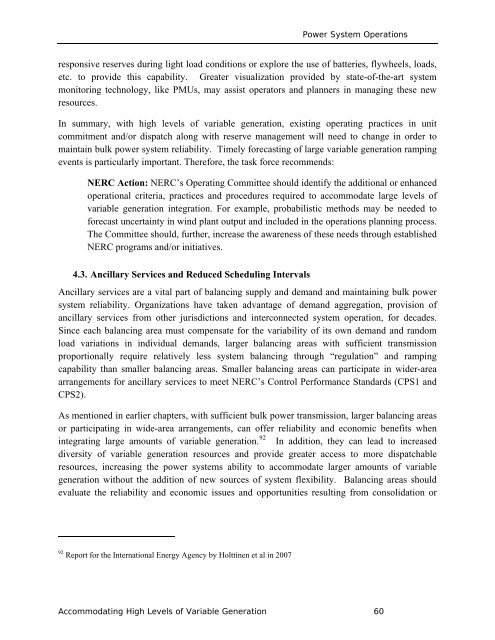Accommodating High Levels of Variable Generation - NERC
Accommodating High Levels of Variable Generation - NERC
Accommodating High Levels of Variable Generation - NERC
Create successful ePaper yourself
Turn your PDF publications into a flip-book with our unique Google optimized e-Paper software.
Power System Operations<br />
responsive reserves during light load conditions or explore the use <strong>of</strong> batteries, flywheels, loads,<br />
etc. to provide this capability. Greater visualization provided by state-<strong>of</strong>-the-art system<br />
monitoring technology, like PMUs, may assist operators and planners in managing these new<br />
resources.<br />
In summary, with high levels <strong>of</strong> variable generation, existing operating practices in unit<br />
commitment and/or dispatch along with reserve management will need to change in order to<br />
maintain bulk power system reliability. Timely forecasting <strong>of</strong> large variable generation ramping<br />
events is particularly important. Therefore, the task force recommends:<br />
<strong>NERC</strong> Action: <strong>NERC</strong>’s Operating Committee should identify the additional or enhanced<br />
operational criteria, practices and procedures required to accommodate large levels <strong>of</strong><br />
variable generation integration. For example, probabilistic methods may be needed to<br />
forecast uncertainty in wind plant output and included in the operations planning process.<br />
The Committee should, further, increase the awareness <strong>of</strong> these needs through established<br />
<strong>NERC</strong> programs and/or initiatives.<br />
4.3. Ancillary Services and Reduced Scheduling Intervals<br />
Ancillary services are a vital part <strong>of</strong> balancing supply and demand and maintaining bulk power<br />
system reliability. Organizations have taken advantage <strong>of</strong> demand aggregation, provision <strong>of</strong><br />
ancillary services from other jurisdictions and interconnected system operation, for decades.<br />
Since each balancing area must compensate for the variability <strong>of</strong> its own demand and random<br />
load variations in individual demands, larger balancing areas with sufficient transmission<br />
proportionally require relatively less system balancing through “regulation” and ramping<br />
capability than smaller balancing areas. Smaller balancing areas can participate in wider-area<br />
arrangements for ancillary services to meet <strong>NERC</strong>’s Control Performance Standards (CPS1 and<br />
CPS2).<br />
As mentioned in earlier chapters, with sufficient bulk power transmission, larger balancing areas<br />
or participating in wide-area arrangements, can <strong>of</strong>fer reliability and economic benefits when<br />
integrating large amounts <strong>of</strong> variable generation. 92 In addition, they can lead to increased<br />
diversity <strong>of</strong> variable generation resources and provide greater access to more dispatchable<br />
resources, increasing the power systems ability to accommodate larger amounts <strong>of</strong> variable<br />
generation without the addition <strong>of</strong> new sources <strong>of</strong> system flexibility. Balancing areas should<br />
evaluate the reliability and economic issues and opportunities resulting from consolidation or<br />
92 Report for the International Energy Agency by Holttinen et al in 2007<br />
<strong>Accommodating</strong> <strong>High</strong> <strong>Levels</strong> <strong>of</strong> <strong>Variable</strong> <strong>Generation</strong> 60
















